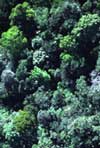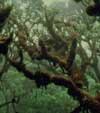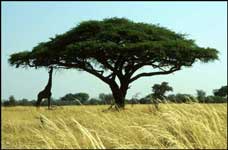THE NATURAL ENVIRONMENT
Geography 101
ToC
LIFE
Animals
Biomes
Tropics
Temperate
Cold
Hawai'i
Tropical Biomes
|
|
BOX 1 |
The distribution of tropical biomes depends largely on the location and movement of the major source of rainfall: the Intertropical Convergence Zone (ITCZ). (Refer to Chapter 4 ->Global and Chapter 6 ->Lifting). The ITCZ follows the sun north and south with the seasons, reaching its northernmost point in June and southernmost point in December. Equatorial areas generally receive enough rainfall year round to support forest, but areas further poleward have a seasonal rainfall pattern that depends on the annual cycle of ITCZ movement. Grassland dominates these seasonal rainfall areas. Further poleward still, subtropical High pressure dominates (refer to Chapter 4 ->Global). Remember, under high pressure, air sinks and clear skies prevail. These high pressure centers account for the broad bands of desert near 20° to 35° North and South latitude in both hemispheres.

Tropical Forest
Tropical forest ranges from continuously wet, hot, lowland tropical rainforests to seasonal (monsoon) forests to wet, cool, highland tropical montane cloud forests.
 The
most widely distributed are the lowland tropical
rainforests. These biomes house the greatest
diversity of life that exists on Earth today. They are old, old forests.
Biologists believe they have remained stable for millions
of years,
even while ice sheets covered higher latitude areas during glacial periods.
The
most widely distributed are the lowland tropical
rainforests. These biomes house the greatest
diversity of life that exists on Earth today. They are old, old forests.
Biologists believe they have remained stable for millions
of years,
even while ice sheets covered higher latitude areas during glacial periods.
 Because
of the year-round growing season and generally poor quality of soils,
the competition for nutrients and sunlight
among trees is intense. They grow tall, straight trunks that support
wide canopies designed to soak up the maximum sunlight.
Their roots fan out sideways seeking to absorb nutrients
from fast decaying
plant litter on the ground. Because of their shallow root systems, the
trees often grow web-shaped buttresses at their base
for support. The ground between the trees is often free of undergrowth,
simply a carpet of leaves, because the dense canopies block most sunlight
from reaching the surface. Epiphytes (non-rooting
plants like orchids) grow in the tree crowns living off decaying leaves
and lianas (vines)
hang in the open space below the canopy.
Because
of the year-round growing season and generally poor quality of soils,
the competition for nutrients and sunlight
among trees is intense. They grow tall, straight trunks that support
wide canopies designed to soak up the maximum sunlight.
Their roots fan out sideways seeking to absorb nutrients
from fast decaying
plant litter on the ground. Because of their shallow root systems, the
trees often grow web-shaped buttresses at their base
for support. The ground between the trees is often free of undergrowth,
simply a carpet of leaves, because the dense canopies block most sunlight
from reaching the surface. Epiphytes (non-rooting
plants like orchids) grow in the tree crowns living off decaying leaves
and lianas (vines)
hang in the open space below the canopy.
 The
world's major stands of tropical rainforest are found in the equatorial
areas of Africa (Congo Basin), South America (Amazon
Basin), and Southeast Asia. At the margins of these core areas, somewhat
drier conditions prevail and a more open seasonal, or monsoon,
forest
grows. An example would be the teak forests of India and Burma. Because
the canopy is more open, dense underbrush often grows. These forests
are probably most famous in western lore for supporting swarms of leeches,
which reach out from the dense undergrowth and attach themselves to
passing animals.
The
world's major stands of tropical rainforest are found in the equatorial
areas of Africa (Congo Basin), South America (Amazon
Basin), and Southeast Asia. At the margins of these core areas, somewhat
drier conditions prevail and a more open seasonal, or monsoon,
forest
grows. An example would be the teak forests of India and Burma. Because
the canopy is more open, dense underbrush often grows. These forests
are probably most famous in western lore for supporting swarms of leeches,
which reach out from the dense undergrowth and attach themselves to
passing animals. 
A somewhat different forest type covers the upper slopes of tropical mountains. Here, in the cooler air, perpetual clouds cover the slopes. The trees grow short and gnarled. Water drips from the leaves and thick mosses cloak the limbs and trunks. These tropical cloud forests are quiet and still, but uncomfortable places for humans. They support a variety of unusual creatures, however, including the mountain gorillas of central Africa.
Survival of tropical forests is a major conservation issue today as their host countries are rapidly cutting them down to generate badly needed income. As noted in the previous chapter (Chapter 7 -> Water Out), deforestation has serious environmental consequences such as soil erosion and flash flooding. Also, because they contain such as large variety of species, tropical rainforests have the highest extinction rate of any biome.
Savanna
 Tropical
grassland is called savanna. The savannas occupy tropical
lands between the forests near the equator and the tropical
deserts poleward, with a major exception in the equatorial areas of East
Africa. As noted above, they have wet and dry seasons that depend on
the position
of
the ITCZ.
Water
deficits
during
the dry
season
do not allow continuous forest to survive. The climate is less hostile
to humans than in rainforests and the soils are slightly less weathered
and depleted
of nutrients, though still fairly infertile. Before the development of large cities,
savannas supported the largest human
populations in Africa
and anthropologists believe the human species evolved
from this environment.
Tropical
grassland is called savanna. The savannas occupy tropical
lands between the forests near the equator and the tropical
deserts poleward, with a major exception in the equatorial areas of East
Africa. As noted above, they have wet and dry seasons that depend on
the position
of
the ITCZ.
Water
deficits
during
the dry
season
do not allow continuous forest to survive. The climate is less hostile
to humans than in rainforests and the soils are slightly less weathered
and depleted
of nutrients, though still fairly infertile. Before the development of large cities,
savannas supported the largest human
populations in Africa
and anthropologists believe the human species evolved
from this environment.
Savanna vegetation consists of a continuous grass layer with scattered trees or bushes. Anyone who has watched a nature show of African wildlife has seen savanna. The classic tree is the flat-topped acacia, which giraffes keep neatly pruned. In Australia, eucalyptus trees dot the savanna biome. Savanna covers more than half of the African continent, and substantial portions of Australia, South America and India.
African savanna is perhaps most famous for supporting large herds of ungulates, like zebras and wildebeests that migrate north and south each season to follow the rains. Development has blocked most of the traditional migration routes however, and Africa's huge migratory herds are rapidly vanishing.
Tropical Desert
True deserts receive less than 250 mm (10 inches) of rainfall per year. In these areas, year-round stable atmospheric conditions account for the low rainfall totals (review Chapter 5 -> Stability). Stability for most tropical deserts is caused by sub-tropical High pressure (review Chapter 4->Global). Recall that air descends toward the surface in high pressure systems producing clear skies and dry conditions. Stability also occurs in areas with cool offshore currents and upwelling , such as the western coastal deserts of southern Africa and South America. Cool currents cause the driest spot on Earth, in fact: the coastal Atacama Desert in northern Chile. Other desert areas are located in the lee of mountain ranges, such as north-central Mexico, where the rainshadow effect contributes to dryness.
In addition to dryness, life in tropical deserts must cope with temperature extremes. Because of clear skies and copious sunlight energy, the ground surface in continental areas of tropical deserts may rise to over 70° C (158° F) during the day. At night the ground cools rapidly as no clouds block longwave radiation loss to space. These conditions can produce extreme daily surface temperature ranges of 40° C (72° F) or more. In Saudi Arabia, a 50° C (90° F) surface temperature range was once measured.
 Desert
vegetation has adapted a number of extreme strategies to cope with dry,
hot conditions. The drought evaders simply
die when conditions become to dry for survival, but leave behind hardy
seeds.
When the next rain comes, the seeds germinate and the plant cycle begins
again. The drought resisters take less drastic measures
and try to survive long dry periods by:
Desert
vegetation has adapted a number of extreme strategies to cope with dry,
hot conditions. The drought evaders simply
die when conditions become to dry for survival, but leave behind hardy
seeds.
When the next rain comes, the seeds germinate and the plant cycle begins
again. The drought resisters take less drastic measures
and try to survive long dry periods by:
- Having large, deep root systems (remember the root zone from Chapter 7 -> Balance?).
- Storing water in tissues, like cacti.
- Reducing transpiration loss. Many desert plants have waxy coatings to reduce transpiration. Some transpire at night (like pineapple) when it is cooler. Still others have evolved their leaves into rolled-up spines resembling thorns to limit stomata exposure to air.
 Animals,
too, must adapt to the dry, hot conditions. Many are nocturnal (active
at night) to avoid the daytime heat. Many
live beneath the ground where it is cooler. Some migrate during the driest
periods. Some store water, like camels, which can live a week in the
desert without water. The bat eared fox uses its huge ears as radiators
to cool down. Humans can survive just fine in deserts if they
have enough water to drink. If not, the body loses water continuously
through sweating, which causes blood to thicken, kidney dysfunction,
and the circulation system to fail.
Animals,
too, must adapt to the dry, hot conditions. Many are nocturnal (active
at night) to avoid the daytime heat. Many
live beneath the ground where it is cooler. Some migrate during the driest
periods. Some store water, like camels, which can live a week in the
desert without water. The bat eared fox uses its huge ears as radiators
to cool down. Humans can survive just fine in deserts if they
have enough water to drink. If not, the body loses water continuously
through sweating, which causes blood to thicken, kidney dysfunction,
and the circulation system to fail.
A major environmental issue occurs at the margins of deserts where overuse by humans causes desertification. Desertification simply means soil degradation by over-grazing and over-farming. Once this happens, it may take decades to restore soil fertility in the harsh, dry environment.